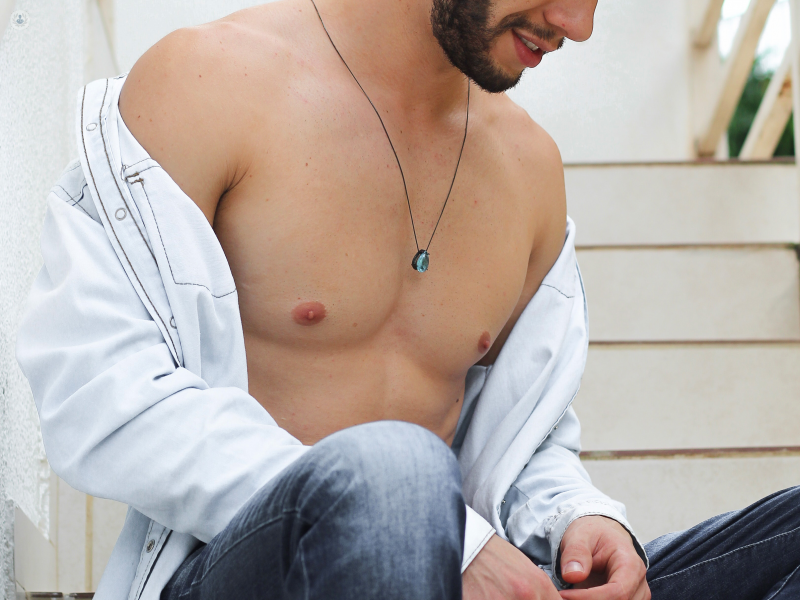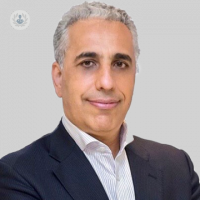Gynaecomastia: why you have ‘man boobs’ and what you can do about them
Written in association with:Gynaecomastia, in simple terms, means abnormally large breasts in men and derives from the Greek words ‘gyne’, meaning women, and ‘mastos’ meaning breasts. The condition is relatively common and affects approximately 40% of men.
Gynaecomastia can cause feelings of shame, self-hate, inadequacy and sufficient embarrassment to interfere with a patient's social life and confidence. We spoke to Professor Kefah Mokbel, a renowned oncoplastic surgeon, to understand more about this condition, what causes it and how men can get it treated.

What are the causes of gynaecomastia?
For many men, enlarged breasts are simply a result of having too much fat around the chest area; however, there can be many other causes. Here’s a list of all the possible reasons you have gynaecomastia:
- Idiopathic — for most cases, there is no obvious cause
- Puberty — 50% of adolescent boys have the condition
- Steroids — mostly used by bodybuilders, these drugs can alter hormone stability, increasing oestrogen production
- Obesity — can cause increased levels of oestrogen and excess fat
- Medical drugs — estrogens, cimetidine, antidepressants, digoxin, spironolactone, anti-psychotics, steroids, etc.
- Genetic causes — the condition can run in families Social drugs — marijuana, alcohol, heroin, amphetamines have been linked in gynaecomastia
- Cancer of the breast and testicles — while it can be a cause, it is very rare
- Chronic liver disease — causes high oestrogen levels, resulting in enlarged breast tissue
- Kidney disease — changes in hormone levels are associated with gynaecomastia
- Klinefelter syndrome — gynecomastia results from decreased levels of testosterone
- Testicular insufficiency — hypogonadism can affect certain masculine characteristics
- Thyroid problems — Hypothyroid men have reduced testosterone secretion
How is gynaecomastia diagnosed?
A patient with gynaecomastia should be seen by a breast specialist to identify the potential cause and exclude any sinister conditions, such as breast and testicular cancer. The diagnosis of gynecomastia is usually made based on clinical examination by the specialist who will also examine the abdomen and testicles.
An ultrasound scan can confirm the diagnosis when the condition is unilateral. Blood tests, which can exclude a hormonal cause and cancer, are usually required but rarely reveal an abnormality. These blood tests include thyroid function tests, sex hormones, prolactin, liver function tests and markers for testicular cancer (AP and hCGH).
Can gynecomastia be fixed without surgery?
Most cases of gynecomastia are idiopathic and mild in severity. In such cases, the patient can be reassured and no specific treatment is required. Optimising body weight and minimising alcohol intake can help in reducing the size of gynecomastia.
Gynaecomastia in teenage boys tends to resolve by itself in around 90% of cases and will be followed up for 1-2 years. The cause, if identified, should be removed (e.g. the drug causing the condition) or the underlying medical condition should be treated. Drug-induced gynecomastia resolves when the drug causing the condition is stopped.
Painful gynaecomastia may be treated successfully with tamoxifen (5-10 mg per day) for 6 months. This drug modulates the oestrogen receptor responsible for the growth of cancerous cells. It is usually used to treat breast cancer at a dose of 20 mg.
Some patients may require psychological counselling.
What is surgery like for gynecomastia?
Surgical correction remains the most effective treatment of gynaecomastia when it is causing symptoms and interfering with the patient’s quality of life. The best surgical technique involves a combination of surgical excision of the glandular component and liposuction of the fatty component if required. The excessive skin tends to shrink over time.

I recommend the avoidance (if possible) of techniques which involve removal of excessive skin and free transfer of nipples given the inferior cosmetic results associated with these techniques. I tend to use a scar around the nipple (below the nipple) to remove the glandular component and leave the skin to shrink over time, especially in younger patients. In some patients, there may be excessive redundant skin that may require surgical reduction using plastic surgery techniques.
Liposuction alone (under local anaesthesia and sedation) is effective for pseudo-gynecomastia - a form of gynecomastia that is caused by excessive fatty tissue in the breasts.
What happens after gynecomastia surgery?
During your recovery from surgery, you are usually seen just once in the clinic for a review of your wound to check that it is healing properly. While most of the time, patients recover without complications, some develop fluid accumulation at the site of surgery, which is known as a seroma. This is usually self-limiting but may require fine needle aspiration.
If you have gynaecomastia and would like to get it treated, Professor Kefah Mokbel can help you. Visit his Top Doctors profile and book a consultation with him.


